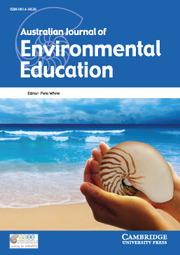Stephen Sterling’s lifelong work lies at the crossroads of sustainability, education, and the study of preferable futures for society. His most recent book, Learning and Sustainability in Dangerous Times, offers a curated selection of his past writings and also provides new chapters, exploring alternative paradigms and the meaning of education in challenging times. The book serves as both an introduction to his academic work and a contribution to the field of sustainability education. While forming a coherent whole, chapters can be read as a stand-alone piece.
This book explores critical questions to achieving a sustainable society and demonstrates how learning and education can play a decisive role in such an endeavour. Central questions addressed include: What is the nature of the change in consciousness necessary for creating a more ecologically sustainable and liveable world? What changes are required in the way we view and practice education to contribute fundamentally to this shift? (p. 4). Striving to articulate a “robust and convincing alternative educational paradigm” (p. 69), Sterling aims to help shift education and society toward a preferable future, making a case for contributing to the ongoing Great Transition Initiative (GTI).
Sterling’s central argument is that achieving a sustainable future requires transcending the mechanistic view of reality, which is identified as “the root cause of today’s social and ecological crises” (p. 5). Whereas a mechanistic worldview is characterised by “anthropocentrism, individualism, materialism, consumerism, economism, and extractivism,” a relational or ecological worldview is “consistent with the Earth-centered worldviews that characterize indigenous cultures” (p. 5). The message is clear: “If we want a sustainable future, we need to think relationally” (p. 177).
The term “sustainable education” describes change in educational culture based upon ecological worldviews. As Sterling highlights, sustainable education is “more than an isolated ‘education for sustainability’ programme, it is about a shift of personal consciousness and educational culture” (p. 188). This shift, he contends, is possible through transformative learning, which can lead to “qualitative shift in perception and meaning making […] such that the learner questions or reframes his/her assumptions or habits of thought” (p. 151). Building on the work of Gregory Bateson (Reference Bateson2002, Reference Bateson2008), Sterling explores how learning involves and affects different levels of knowing and of consciousness, and when those shift, new alternatives and perspectives are considered by the learner (pp. 61, 112, 152). Sustainable education involves movement in three interrelated areas of human knowing and experience: perception (or the affective dimension), conception (or the cognitive dimension), and practice (or the intentional dimension)” (p. 188).
The book is divided into five parts:
Part 1: The View from Here introduces the current global crisis and the necessity of achieving planetary consciousness through collective learning (Chapter 1), explores the responsibility of education to enable transformative change through an ecological paradigm (Chapter 2), and outlines key ideas and frameworks, including 50 propositions to stimulate critical reflection (Chapter 3).
Part 2: Platform Pieces lays down foundational perspectives, discussing social and environmental challenges (Chapter 4) and contrasting education for a “world we don’t want” with education for a “great transition” (Chapter 5);
Part 3: Re-thinking Education critiques current educational policies, particularly neoliberal influences and advocates for a reimagined, sustainable purpose for education (Chapter 6);
Part 4: Re-thinking Our Thinking shares some implications of mechanistic and relational worldviews on education and learning (Chapter 7), reviews perspectives on environmental and sustainability education (Chapter 8), presents transformative learning theory (Chapter 9), the “Triang Model” of Seeing, Knowing, and Doing (Chapter 10), and discussions on language, ecological intelligence, and humanity’s paradoxical inaction in the face of catastrophe (Chapters 11–13);
Part 5: Change-ability provides practical tools and models to advance this work, emphasising systems thinking as a vital way of seeing and engaging with the world (Chapter 14) and concluding with a call for active participation (Chapter 15).
Scholars, educators, and practitioners working at the intersection of education [...] and sustainability will benefit from reading this book. The book provides conceptual tools to facilitate a paradigm shift in education and educational institutions. A key strength of the book is the set of conceptual models that support Sterling’s arguments. For instance, his “levels of knowing” model illustrates that learning takes place at various scales, involving numerous meanings and ways of knowing (p. 152). Additionally, his “Triang Model” illustrates that seeing, knowing and doing are three interrelated processes, through which shifts required to generate an ecological paradigm can take place.
Sterling’s contributions align with those of many other thought leaders in the field of sustainability education, including Paul Raskin’s Great Transition Initiative (GTI) (Reference Raskin2013), David Orr’s call to address “the long emergency” we are facing globally (Reference Orr2016), and Elizabeth Lange’s work on transformative sustainability education (Reference Lange2023).
Looking ahead, Sterling’s book contributes to the practical tools to assist teachers and schools in fostering transformative learning and sustainable education. The author prompts and addresses the question of how quality learning environments can be created to enable transformative learning within current educational systems. Sterling’s manuscript will remain a valuable resource for current and emerging thinkers and change-makers, offering significant support to educators, policymakers and researchers dedicated to advancing sustainability through education.
Author Biography
Rosemarie Desmarais holds a master’s degree in educational studies from the University of British Columbia and a B.Sc. in International Studies from the University of Montreal. Her work as a researcher-practitioner lies at the intersection of education, sustainability, ecology and social change. She currently works for The Cloud Institute for Sustainability Education.



